IoT Architecture Explained: 5-Layer Framework & Industrial Applications
 Arpit Shrivastava
Arpit ShrivastavaIntroduction
After a decade in the IoT industry, I've witnessed the evolution from simple connected devices to complex, intelligent systems transforming entire industries.
The Internet of Things isn't just about connecting devices.
It's about creating value through data-driven insights and automation.
My journey has taken me across multiple sectors - from smart agriculture to industrial manufacturing and urban infrastructure.
Each project has taught me valuable lessons about what works, what doesn't, and where the true challenges lie.
In this article, I'll share my experience building IoT solutions from the ground up.
I'll walk you through each layer of the IoT stack and highlight real-world applications and challenges.
Whether you're a seasoned developer or just starting your IoT journey, I hope these insights prove valuable.
The IoT Ecosystem: A 5-Layer Approach
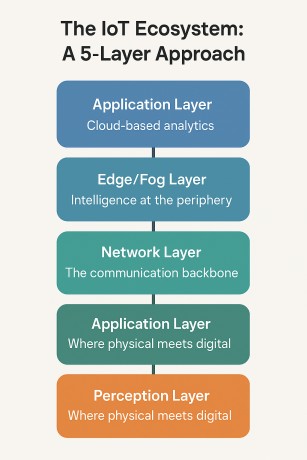
Many people think of IoT as simply "connected devices."
But the reality is far more complex and fascinating.
To truly understand IoT, we need to examine its five distinct layers:
Perception Layer - Where physical meets digital
Network Layer - The communication backbone
Edge/Fog Layer - Intelligence at the periphery
Data Processing Layer - Cloud-based analytics and storage
Application Layer - User interfaces and business integration
Let's dive into each layer and explore how they work together to create powerful IoT solutions.
Layer 1: Perception Layer - Where It All Begins
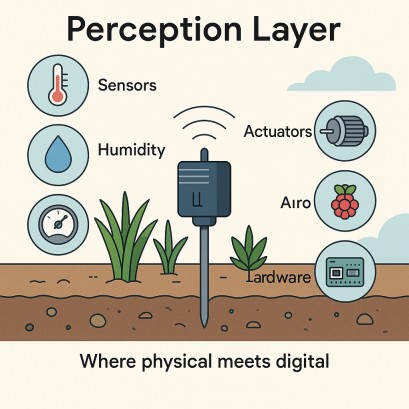
The Digital Senses of IoT
The perception layer is the foundation of any IoT system.
It's where the physical world gets translated into digital data.
This layer consists of sensors that capture environmental data and actuators that can affect physical change.
Think of these as the "eyes," "ears," and "hands" of your IoT solution.
In my work with agricultural clients, we've deployed soil moisture sensors across thousands of acres.
These tiny devices continuously monitor water content at different soil depths.
The data forms the basis for automated irrigation systems that have reduced water usage by up to 30%.
Key Components
The heart of this layer includes:
Sensors: Temperature, humidity, pressure, motion, light, etc.
Actuators: Motors, valves, switches, and relays
Hardware platforms: Arduino, ESP32, Raspberry Pi, custom SoCs
The choice of components depends heavily on your specific application needs.
For industrial environments, we often use ruggedized sensors that can withstand extreme temperatures and vibrations.
In contrast, consumer applications might prioritize cost and battery efficiency.
Real-World Challenges
Working with the perception layer isn't without its hurdles:
- Sensor calibration is a persistent challenge, especially in varying environments.
A temperature sensor that works perfectly in a climate-controlled warehouse may drift significantly when deployed in a desert.
- Power management remains the Achilles' heel of many IoT deployments.
Balancing battery life with data collection frequency requires careful optimization.
I once worked on a project where we reduced sensing frequency from every minute to every five minutes.
This simple change extended battery life from three months to over a year.
- Environmental durability is another critical factor often overlooked during initial development.
I've seen expensive sensors fail within weeks due to dust infiltration or moisture damage.
Proper IP rating and environmental testing are absolute musts for real-world deployments.
Layer 2: Network Layer - The Communication Backbone
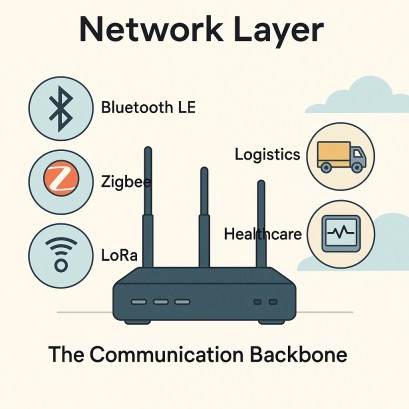
Connecting the Dots
Once data is captured, it needs to travel somewhere useful.
The network layer handles this critical transmission function.
It's responsible for protocols, gateways, and ensuring data flows securely from sensors to processing systems.
The choice of connectivity technology can make or break an IoT project.
I've seen beautifully designed systems fail simply because the wrong communication protocol was selected.
Connectivity Options
The IoT connectivity landscape is vast and varied:
- Short-range protocols like Bluetooth LE, Zigbee, and Z-Wave excel in home and office environments.
They offer good battery life but limited range.
- Medium-range solutions like LoRaWAN and Sigfox can cover several kilometers.
They're ideal for smart city applications where power is limited but coverage needs are extensive.
- Cellular options (NB-IoT, LTE-M, 5G) provide the greatest range and reliability.
But they come with higher power requirements and often recurring connectivity costs.
Industry Applications
Different industries leverage different connectivity approaches:
- In logistics, I helped implement a tracking system using LoRaWAN for warehouse monitoring.
It switches to cellular when vehicles leave the facility.
- For healthcare applications, we often rely on BLE for patient monitoring devices.
These connect to central gateway stations throughout hospital floors.
- In remote industrial sites, like oil and gas facilities, we've created hybrid networks.
These combine satellite backhaul with local mesh networks for comprehensive coverage.
Real World Challenges - Network Layer
The network layer presents unique challenges:
- Intermittent connectivity is a fact of life in many IoT deployments.
Your system must be robust enough to buffer data and handle reconnections gracefully.
- Network congestion becomes a serious issue at scale.
When thousands of devices try to communicate simultaneously, collisions and delays are inevitable.
Implementing proper back-off algorithms and data prioritization is essential.
- Security vulnerabilities are particularly acute at this layer.
Man-in-the-middle attacks, packet sniffing, and device spoofing are all real threats.
I always insist on transport layer security, device authentication, and encrypted payloads as minimum requirements.
Layer 3: Edge/Fog Layer - Intelligence at the Periphery
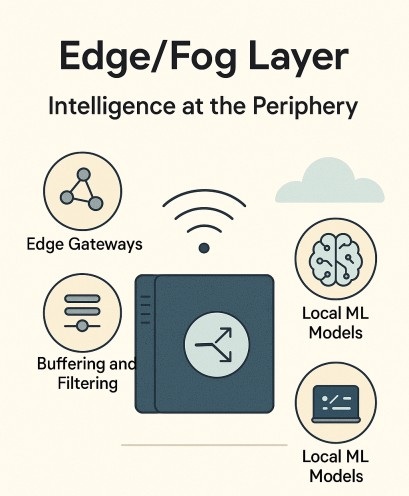
Processing at the Source
Not all data needs to travel to the cloud for processing.
The edge layer brings computation closer to the data source.
This approach reduces latency, bandwidth usage, and often costs.
Edge computing has transformed how we architect IoT solutions.
In one manufacturing project, we reduced cloud data transmission by 95%.
We achieved this by processing raw vibration data at the edge and sending only anomaly alerts and summaries to the cloud.
Key Edge Computing Elements
The edge layer typically involves:
Edge gateways that aggregate data from multiple sensors
Local processing units for real-time analysis and decision making
Buffering and filtering to optimize what gets sent to the cloud
Local machine learning models for intelligence without cloud dependency
Real-World Applications
Edge computing shines in numerous industrial scenarios:
- In manufacturing environments, edge systems analyze machine vibrations in real-time.
They can shut down equipment before catastrophic failures occur.
- For energy sector clients, edge computing enables substation automation.
It provides millisecond-level responses to grid anomalies that cloud processing couldn't match.
- In retail settings, edge systems process camera feeds for customer analytics.
They deliver insights without sending potentially sensitive video to the cloud.
Real World Challenges - Edge Layer
Working at the edge introduces specific challenges:
- Hardware constraints limit what processing you can perform locally.
Optimizing algorithms for limited CPU, memory, and power is a specialized skill.
- Software updates become complicated when devices are deployed in remote or secure locations.
I've developed staged update mechanisms with automatic rollback capabilities to address this.
- Standardization remains elusive in the edge computing space.
Each platform has its own development paradigm and management approach.
This makes creating consistent deployment processes challenging.
Layer 4: Data Processing Layer - Cloud Intelligence
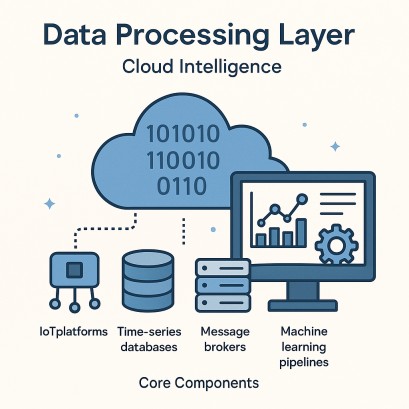
The Brain of IoT Operations
The data processing layer is where the real magic happens.
It transforms raw data into actionable insights through storage, analysis, and machine learning.
This layer typically lives in the cloud, though hybrid approaches are becoming more common.
The scale of data processing in mature IoT systems can be staggering.
In one smart city project, we processed over 2 TB of sensor data daily.
This came from traffic systems, environmental monitors, and utility infrastructure.
Core Components
A robust data processing layer includes:
IoT platforms like AWS IoT Core, Azure IoT Hub, or Google Cloud IoT
Specialized databases optimized for time-series data
Message brokers for reliable data ingestion at scale
Analytics engines for batch and stream processing
Machine learning pipelines for predictive capabilities
Industry Impact
The data processing layer drives value across multiple industries:
- In smart manufacturing, cloud-based quality control systems analyze product images.
They detect defects with greater accuracy than human inspectors.
- For agriculture clients, we've built prediction models for crop disease.
These integrate weather data, soil conditions, and historical patterns.
- In energy management, cloud systems optimize HVAC operations across building portfolios.
They balance comfort with energy efficiency, saving millions in operating costs.
Real World Challenges - Data Processing
This layer brings its own set of challenges:
- Data volume management becomes critical as systems scale.
Time-series databases must be carefully tuned and partitioned.
- Cost control requires careful attention to compute resources and data storage.
I've seen cloud bills explode when systems were built without considering data lifecycle management.
- Compliance requirements add complexity, especially in regulated industries.
GDPR, HIPAA, and other regulations impose strict requirements on data handling and storage.
Layer 5: Application Layer - Making Data Useful
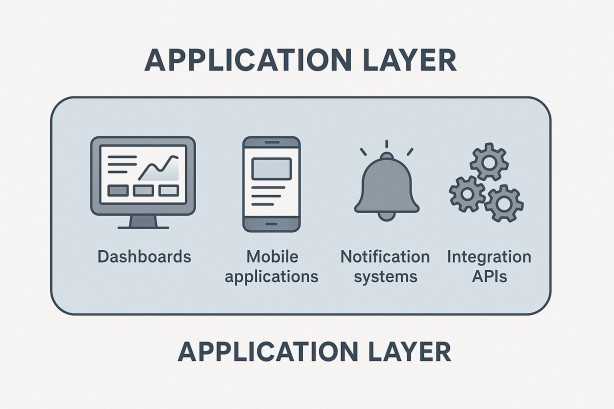
Bringing IoT to Users
The application layer is where data becomes truly valuable to humans.
It transforms insights into intuitive interfaces, alerts, and automated actions.
This is the layer most users actually interact with.
Despite its importance, the application layer often receives insufficient attention.
I've seen technically brilliant IoT solutions fail because they lacked intuitive user interfaces.
Application Components
Effective application layers include:
Dashboards and visualization tools that present data clearly
Mobile applications for on-the-go monitoring and control
Notification systems for alerting users to important events
Integration APIs for connecting with business systems like ERP or CRM
Automation rules engines for creating programmable responses
Real-World Impact
The application layer delivers the promise of IoT to end users:
- Fleet managers use interactive maps to track vehicles and receive automated alerts.
These notifications trigger when vehicles deviate from routes or show maintenance issues.
- Building operators rely on energy dashboards to monitor consumption patterns.
They can identify waste and optimize operations across facilities.
- Healthcare providers use patient monitoring interfaces to track vital signs.
These systems alert staff when readings fall outside safe parameters.
Real world challenges - Application Layer
Creating effective IoT applications comes with challenges:
- User experience design is crucial yet often overlooked.
IoT interfaces must be intuitive for non-technical users while presenting complex data meaningfully.
- Real-time requirements can strain backend systems.
Users expect dashboards to update instantly and alerts to arrive immediately when conditions change.
- Integration complexity increases when connecting with enterprise systems.
Creating seamless workflows between IoT platforms and existing business software requires deep system knowledge.
Building Successful IoT Solutions: Lessons Learned
After a decade of building IoT systems, certain patterns of success have become clear.
Here are my most important lessons:
A. Start with the Business Problem, Not the Technology
I've seen too many projects begin with technology and search for problems to solve.
The most successful IoT implementations start with clear business objectives.
Technology choices should flow from those needs, not the other way around.
B. Design for Scale from Day One
It's tempting to take shortcuts during proof-of-concept phases.
But retrofitting scalability is painful and expensive.
Consider how your solution will handle 100x or 1000x more devices from the beginning.
C. Security Cannot Be an Afterthought
IoT security vulnerabilities can have physical-world consequences.
Implement security at every layer: device, network, cloud, and application.
Regular security audits and penetration testing should be standard practice.
D. Expect and Plan for Failure
Sensors will fail. Networks will go down. Cloud services will have outages.
Robust IoT systems anticipate these failures and degrade gracefully.
Implement circuit breakers, retry mechanisms, and fallback modes throughout your architecture.
The Future of IoT: Where We're Headed
As I look to the next decade of IoT development, several trends stand out:
A. AI at the Edge
Machine learning models are becoming efficient enough to run on constrained devices.
This shift will enable more intelligence at the edge, reducing latency and cloud dependency.
Soon, even basic sensors will include neural processing units for local intelligence.
B. Twins
The concept of digital twins - virtual replicas of physical assets - is gaining traction.
These models enable simulation, prediction, and optimization without disrupting physical operations.
I expect digital twins to become standard for critical infrastructure and industrial systems.
C. Increased Standardization
The fragmented IoT ecosystem is gradually converging on common standards.
Initiatives like Matter (formerly Project CHIP) for smart homes and oneM2M for industrial IoT are gaining momentum.
This standardization will simplify development and improve interoperability.
Conclusion
IoT is no longer just a technological curiosity—it's transforming how businesses operate and how we interact with the world.
The journey from sensors to solutions involves navigating multiple layers of technology.
Each layer presents its own challenges and opportunities.
Success requires not just technical expertise but also a deep understanding of business needs and user experience.
As IoT continues to evolve, the fundamentals remain consistent.
Focus on solving real problems, design for scale and security, and prepare for inevitable failures.
The most effective IoT solutions aren't necessarily the most technologically advanced.
They're the ones that seamlessly integrate into users' lives and deliver clear, measurable value.
I hope sharing my decade of experience helps you on your own IoT journey.
Whether you're just starting out or looking to refine existing systems, remember that IoT success is ultimately measured by the problems it solves, not the devices it connects.
What IoT challenges are you facing in your organization? I'd love to hear about your experiences in the comments below.
Subscribe to my newsletter
Read articles from Arpit Shrivastava directly inside your inbox. Subscribe to the newsletter, and don't miss out.
Written by

Arpit Shrivastava
Arpit Shrivastava
I'm Arpit, Co-Founder of ScroBits. I love talking about IoT, SaaS and Cloud DevOps. We make IT outsourcing fun and effective with our MERN stack expertise. When not in the tech world, I enjoy plogging, mountaineering, and working out. Ready to transform your business? Let's chat and make tech magic happen.